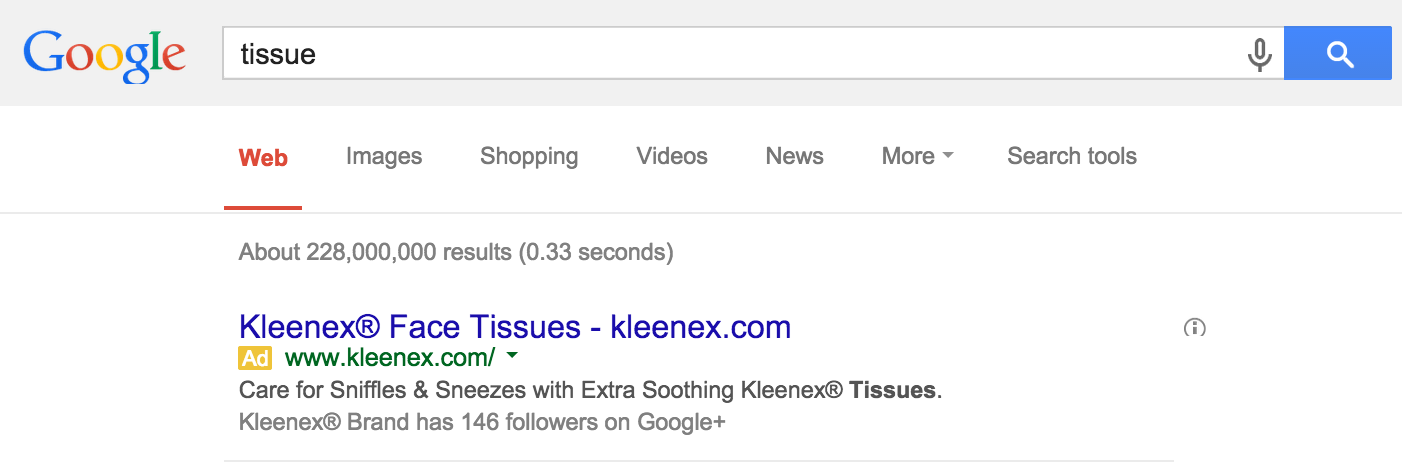Question: When I say “tissue” what comes to mind?
Answer: Kleenex
What about “cheese crackers”?
Okay, you get the point. These two brands have created awareness where you associate their brand immediately for a term (tissue & Kleenex have almost become synonymous). Brand awareness can make or break a business, and it’s something that is most often a focus for traditional marketing channels. When measuring the success of PPC, most often direct response metrics are reports (i.e., conversions, CPL, conversion rate). PPC will also have an impact on brand awareness.
Using Search
The first and most apparent way to use PPC for branding is to use branded keywords. You might also consider bidding high for non-branded keywords that are most important to your brand. For example, if I sell ping-pong balls I might want to bid on “best ping-pong balls” just to get my brand name out there. It’s important to remember that these keywords may be expensive, depending on your vertical.
Another method of using search is to bid on competitor terms and have a solid strategy in place for your ad copy. Be sure to include your value proposition and clear call to action.
Using Display
There are many different ways of targeting your ads on the Display Network that can be taken advantage of for branding specific campaigns. Display advertising can be more top-of-funnel approach because users aren’t specifically searching for your product or service. However, Display makes a good platform to increase your brand’s presence. Try targeting sites you know your demographic visits (assuming it allows GDN ads) or targeting interest groups.
Custom Affinity Audiences
Affinity audiences allow you to find sites on the Display Network that people who might be interested in your product or service visit. Taken to the next step, Google now allows you to create custom affinity audiences, which allows you to personally define an audience. To do this, you simply add a list of URLs that your target audience visits. Be sure to use sites that contain a lot of text relevant to your audience, as well as pages that would allow you to clearly describe the desired audience from significant phrases on the page.
Remarketing
Remarketing can also be used to periodically remind visitors of your brand. There are countless ways to set up a remarketing strategy, especially with Google Analytics remarketing lists, which allow you to create audiences with more specific site behaviors. Using this approach will help increase the likelihood that your brand is “top of mind” for your targeted audience of potential customers.
YouTube
Visual can be a key element to any sort of branding effort, and videos do a great job of providing sight, sound, and movement that users will associate with your brand. With AdWords Video campaigns you can measure traditional direct response metrics such as clicks and conversions, but also how many users viewed your entire video. Google also tracks any shares and likes you get from your video ad.
YouTube also gives you some great targeting options, including interests and keywords. In the above example, Remarketing audiences were used, as well as keywords. Users who searched one of the keywords was less likely to convert, but were more likely to watch the entire video.
Consider using YouTube ads if you already have (or are capable of creating) high quality videos. You should also expect to see a low conversion rate, and high CPL here if you are looking at hard conversion metrics as well as branding.
Measurement
With search and display efforts, you can measure clicks and impressions to get an idea of how many users you are reaching. Also take a peek into Google Analytics to see if there have been any increases in direct or organic traffic since you started PPC advertising (or shifted focus to include a branding strategy).
If you want to take it a step further, Google’s Brand Awareness tool can help you measure changes in brand awareness & ad recall, as well as brand interest stemming from your display and/or video campaigns. From Google’s support page:
“We automatically isolate two groups: a randomized control group that was not able to see your ad and an exposed group who did see your ad. We then ask both groups the same question, allowing us to accurately determine the lift generated by your campaign. To gain further insights, you can cut data by demographics, frequency, and more.”
Brand interest is also measured by comparing increases in organic searches on your brand terms between people who viewed your ad vs. people who did not.
Google consumer surveys are another (albeit not free) method of gauging brand lift. With this option you can create a short 1-question survey which will cost $0.10/form, or a more detailed survey that will be up to $3.50/form.
Closing Thoughts
If your main goal is immediate revenue or profitability, then creating a brand awareness strategy probably isn’t for you. However, if one of your main goals is to get your brand name out there and potentially drive traffic through other channels as well as PPC, then branding might be something for you to think about. There are some ways to gauge how well your branding efforts are performing, but you’ll probably need some help from Google in setting this up (and it might not be free, depending on which option you choose).
What are your thoughts? Have you measured brand awareness before?









